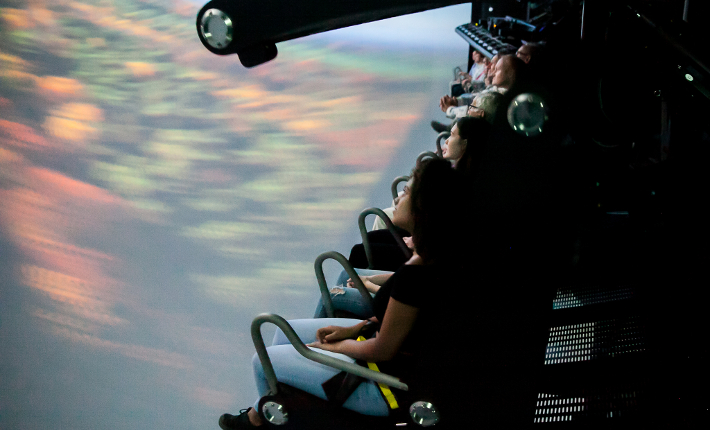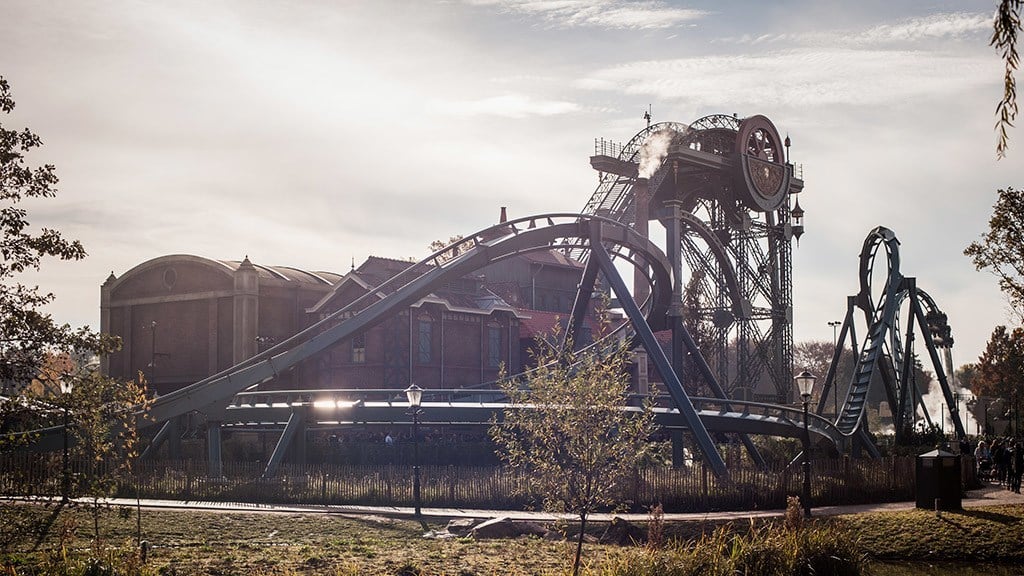Imagine someone is trying to tell you a story. The only problem is, you're flipping upside down at seventy kilometers per hour. It sounds like a bizarre situation, but it's a challenge faced by many theme parks (and, as I will show, also tourist attractions and heritage institutions).
Roller coasters and other fast-paced attractions have become an appealing and successful way to attract an audience. Thrilling and extreme experiences are used in theme parks, heritage parks, and other places that aim to present a story in an engaging way. But using excitement always risks that the thrill overshadows the story. Can you shake someone up and still tell a meaningful story?
Let's take a contemporary example. The roller coaster "De Baron" in the Efteling is a so-called ‘dive coaster,’ where visitors first hang over a smoke-filled abyss before plummeting 37.5 meters in a free fall straight down. The ride is more than just a terrifying roller coaster. During the ride, a story is told about greed and pride. This is conveyed in several ways. The roller coaster is designed (‘themed’) in the style of the late 19th-century gold rush era, complete with steampunk-like industrial mining equipment. While waiting in line, visitors hear the story of Baron Gustave Hooghmoed through voice-overs, signs, and screens. Despite warnings from the ‘Witte Wieven,’ he finds a gold nugget and loses himself to gold fever. It’s a story about greed and capitalist arrogance, intertwined with the Dutch myth of the Witte Wieven. Despite all warnings, Baron Hooghmoed plunges to his doom. The roller coaster with its free fall is a literal representation of the saying, “pride comes before the fall.”

The Efteling is not the only example. Nearly all theme parks not only offer exciting experiences but also embed these experiences in stories. This is actually the main difference between a theme park and an amusement park or a fairground. Theme parks place attractions in a story, a theme, and a moral. For example, at a fairground, you can get shaken up without it being accompanied by a theme, story, or moral. Amusement parks like Coney Island were seen as places where crude entertainment, vulgarity, or otherwise unruly behavior dominated. In the early 20th century, entertainment was increasingly offered to populations in industrialized countries. But as a result, concerns also arose about vulgar entertainment and its immoral consequences.
Theme parks emerged with the goal of offering a responsible, educational, and morally sound alternative to this ‘crude’ entertainment. The Efteling, for example, when it opened in 1952, was a park that provided entertainment aligned with Catholic values, aiming to counter the negative influence of crude amusement. Walt Disney also had the explicit goal of providing responsible entertainment for children and thus competing with places like Coney Island. One sign of this focus on morality that we can still see today is the use of fairy tales. In both the Efteling (think of the Fairy Tale Forest) and the Disney parks (Cinderella, Snow White, etc.), the emphasis is placed on fairy tales and pedagogically sound entertainment. And although Catholicism has disappeared from the Efteling, we see in attractions like De Baron that attractions are still built to tell a moralizing story. Disney, too, likes to see itself as a moral company that teaches children and adults the value of imagination.
Theme parks are places where the latest high-tech entertainment is combined with framing, with a story. But this raises the recurring question of how entertainment and story can be combined. How do theme parks ensure that the entertainment attracts people while also providing meaningful content?
oday, roller coasters around the world frame the experience with a story. In the Efteling, but also in Disney parks, Warner Brothers Movie World, Plopsaland, Europa-Park, Gardaland, Energylandia, Vialand, and parks all over the world, millions of people visit theme parks. You can zoom through the world of the Avengers on a roller coaster, bounce through the world of Disney's Madagascar, or travel through the world of Star Wars. At Dollywood, you can flip upside down on the wings of an eagle. A Bible verse frames this experience as: "Soaring on the Wings of Eagles."
All these examples struggle with the same problem: how can you tell people a story while shaking them up? The body is simply too busy to pay attention. All narrative roller coasters try to combine extreme experience with what is called ‘theming’ in theme park studies. In De Baron, for example, the story is primarily told while waiting in line. You hear voice-overs, and the story is told through the decor. Once you're finally allowed on the roller coaster, not much theming happens anymore. In some roller coasters, there are attempts to incorporate the story during the ride by slowing down to tell a part of the story before speeding up again. This happens in the Flight Force Avengers Coaster, where the visitor is taken into a story about saving the world. Occasionally, the roller coaster stops to tell another piece of the story before shooting off into space again.
This tension between experience and storytelling is not limited to theme parks. It also occurs in other places where experience is used to tell meaningful stories. Take, for example, the phenomenon of 5D flight experience attractions. These are attractions where the visitor remains seated but, through screens, moving seats, and special effects like mist and (3D) projections, gets the feeling of flying. The body experiences the sensation of performing wild aerial acrobatics. These attractions are similar to roller coasters in many ways. Visitors are strapped into roller coaster seats and experience the sensation of flipping upside down at high speeds.
The 'Flight Experience' is a popular feature in theme parks, as well as in heritage institutions and tourist destinations. For example, in various places such as Madurodam, the Natural History Museum Naturalis, Miniatürk, and many other heritage parks and tourist attractions, visitors are invited to sit in flight simulators. In the miniature park Miniatürk, you can fly through Turkish history, in Madurodam, you fly over everything that made the Netherlands great, and in the Rexperience at the Natural History Museum Naturalis in Leiden, you crash after a flight through time and space into the world of dinosaurs. The popularity of these attractions is easy to understand: the experiences are thrilling, they use the latest technological developments, and they are perfect for making certain stories appealing to an audience seeking thrills.
A specific example is "This Is Holland" in Amsterdam. In this 5D Flight Experience, you fly over the Dutch landscape. After several rooms where the history of the Netherlands is told, and a virtual actor humorously explains how delightfully quirky the Netherlands is, we are led into a large room. We are strapped into seats that resemble roller coaster chairs. Then our seats move forward, and we dangle over an abyss. A large curved screen surrounds us. Then the immersive projection begins. Sometimes the camera tilts, sometimes it dives, while we are shaken in our seats in a way that is supposed to make us feel like we're flying. We zoom through the air, spin around our axis, and do somersaults. Then we descend and see the Netherlands. We fly over the Oostvaardersplassen, the Royal Palace on the Dam, and the Zeeland Bridge. Meanwhile, pompous classical music plays. Technically, it's impressive, and if my stomach is to be believed, my body really thinks it's tumbling through the air. The rest of the audience also reacts with sounds of excitement and pleasure.

The idea is that we get an exciting, emotionally impactful, but also informative overview of the Netherlands. A superficial but grandiose nationalist narrative is told: the Netherlands, we learn, is fantastically beautiful and historically rich, and the attraction does everything to convey that story, not only with facts about the Netherlands but also to land that story physically in our bodies. As with many such attractions, only a feel-good story is told here. Through the breathtaking flight, a sense of awe is meant to be evoked. Here, the Netherlands is presented as an emotionally impressive nation.
Still, as you float with your legs in the air above the Dutch landscape, the question arises whether my churning stomach cares if we are flying over the Netherlands or another country. Are the "oohs" and "aahs" of the people around me about the beauty of the Dutch landscape or the technical brilliance? Do people take away anything from this experience, or are they simply enjoying the temporary thrill of weightlessness? This Is Holland tries to excite us about the Netherlands and uses 5D technology to instill admiration and information about the country. But do our bodies feel proud of the Netherlands as we soar over the North Sea, or is the experience detached from the story?
In our research, the connection between experience and meaning, and to what extent they can be controlled, plays a major role, and we will return to these questions often. To answer these questions, you have to experience these places for yourself and personally undergo these attempts to "imagineer" our imagination. But for now, we can return to the question we started with: can you tell people a story while shaking them up?
It remains a constant challenge for all places offering dizzying experiences to attract an audience. It can attract people, but the message may disappear behind the screams and shaking. The best experiences seem to be those where experience and story align. In that respect, De Baron at the Efteling is a convincing example (you tell the audience a story about pride before the fall and then literally make them fall). But whether the screaming visitors plummeting down are actually reflecting on their own greed remains the question.
